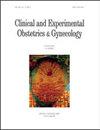Identification of an Immune Cell Infiltration-Related Prognostic Model to Guide Immunotherapy in Endometrial Carcinoma
IF 0.6
4区 医学
Q4 OBSTETRICS & GYNECOLOGY
引用次数: 0
Abstract
Background: Uterine corpus endometrial carcinoma (UCEC) is a prevalent gynaecologic malignancy. It has been demonstrated that the immune cell infiltration (ICI) pattern plays a critical role in the tumour progression of UCEC. Methods: To further investigate the immune microenvironment landscape of UCEC, we analysed the gene expression data of 539 UCEC patients from The Cancer Genome Atlas (TCGA) database using CIBERSORT and ESTIMATE for consensus clustering of immune cells. We used the limma package to compare differentially expressed genes (DEGs) among ICI patterns and constructed a prognostic model using Cox regression to calculate the risk score of UCEC patients. The immunophenoscore was downloaded to explore the immunotherapeutic effect between low- and high-risk score patients. Finally, the tumour mutation burden (TMB) was calculated using the somatic mutation data. Results: We identified two different immune infiltration patterns in 539 UCEC samples, the immune-desert and immune-inflamed phenotypes, which had distinct prognostic and biological features. We obtained 29 DEGs to construct the ICI-related prognostic model and established a four ICI-related gene-based prognostic model comprising LINC01871, CXCL13, IGKJ5, and LINC01281. The risk score was associated with distinct clinical outcomes, ICI, and immunotherapeutic effects. Patients with a low risk score had higher effective immune cells, which could be classified into the immune-inflamed phenotype. Additionally, patients with a low risk score had a significantly higher immunophenoscore, suggesting a better immunotherapeutic outcome. Finally, TMB was confirmed to be associated with prognosis, which was synergistic with the risk score. Conclusions: This study comprehensively analysed the ICI pattern in UCEC patients and established a four ICI-related gene-based prognostic model to predict prognosis and guide precise immunotherapy strategies.子宫内膜癌免疫细胞浸润相关预后模型的鉴定指导免疫治疗
背景:子宫体子宫内膜癌是一种常见的妇科恶性肿瘤。研究表明,免疫细胞浸润(ICI)模式在UCEC的肿瘤进展中起关键作用。方法:为了进一步研究UCEC的免疫微环境景观,我们利用CIBERSORT和ESTIMATE对来自the Cancer Genome Atlas (TCGA)数据库的539例UCEC患者的基因表达数据进行分析,对免疫细胞进行共识聚类。我们使用limma包来比较不同ICI模式的差异表达基因(DEGs),并使用Cox回归构建预后模型来计算UCEC患者的风险评分。下载免疫表型评分(immunophenoscore),探讨低、高危评分患者的免疫治疗效果。最后,利用体细胞突变数据计算肿瘤突变负荷(TMB)。结果:我们在539例UCEC样本中发现了两种不同的免疫浸润模式,免疫荒漠表型和免疫炎症表型,它们具有不同的预后和生物学特征。我们获得了29个基因构建ici相关预后模型,并建立了包括LINC01871、CXCL13、IGKJ5和LINC01281在内的4个ici相关基因的预后模型。风险评分与不同的临床结果、ICI和免疫治疗效果相关。风险评分低的患者有效免疫细胞较高,可归类为免疫炎症表型。此外,低风险评分的患者免疫表型评分明显更高,表明免疫治疗结果更好。最后,证实TMB与预后相关,与风险评分有协同作用。结论:本研究全面分析了UCEC患者的ICI模式,建立了基于四种ICI相关基因的预后模型,预测预后,指导精准的免疫治疗策略。
本文章由计算机程序翻译,如有差异,请以英文原文为准。
求助全文
约1分钟内获得全文
求助全文
来源期刊
CiteScore
0.50
自引率
0.00%
发文量
241
审稿时长
1 months
期刊介绍:
CEOG is an international, peer-reviewed, open access journal. CEOG covers all aspects of Obstetrics and Gynecology, including obstetrics, prenatal diagnosis, maternal-fetal medicine, perinatology, general gynecology, gynecologic oncology, uro-gynecology, reproductive medicine, infertility, reproductive endocrinology, sexual medicine. All submissions of cutting-edge advances of medical research in the area of women''s health worldwide are encouraged.

 求助内容:
求助内容: 应助结果提醒方式:
应助结果提醒方式:


